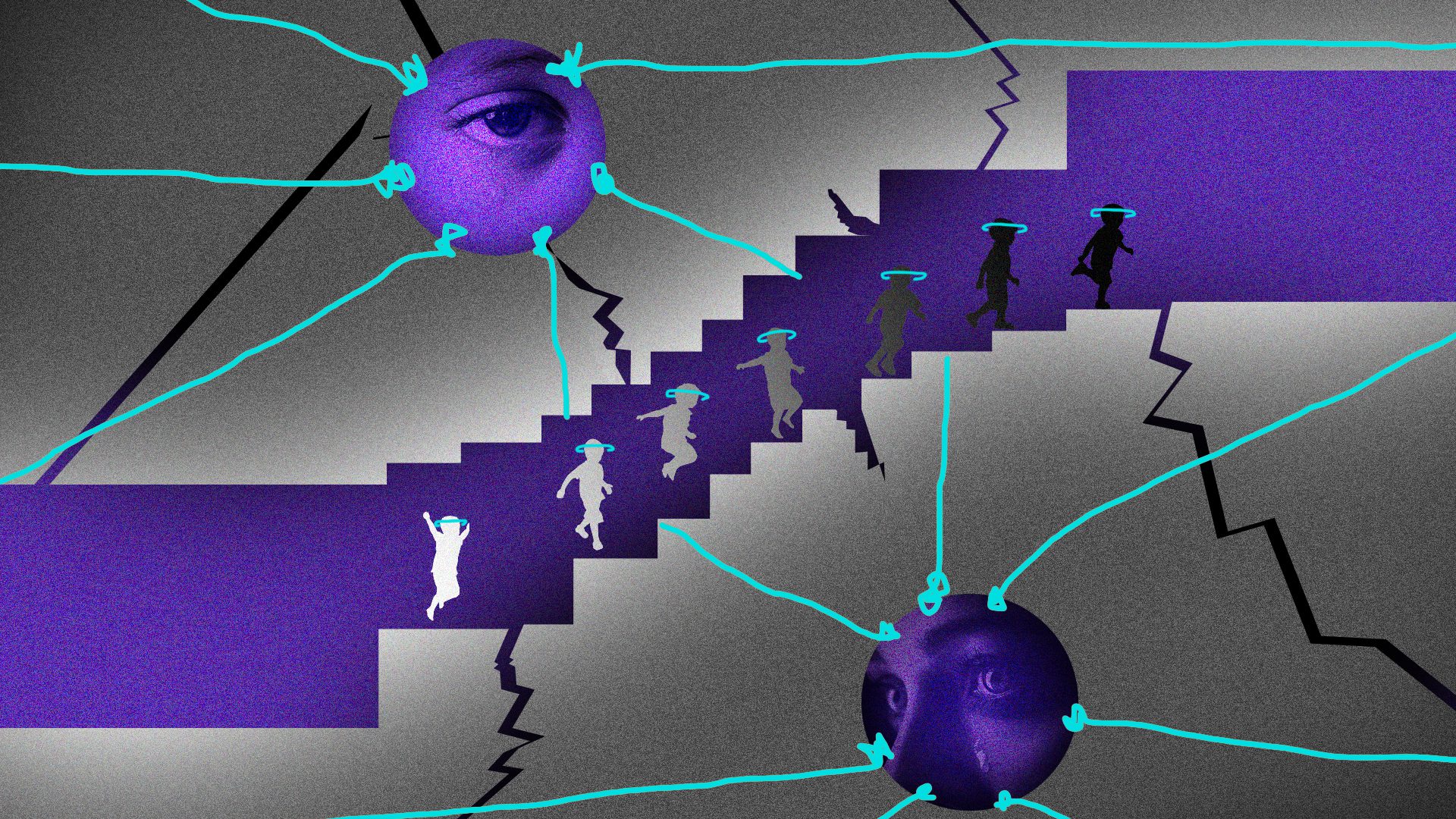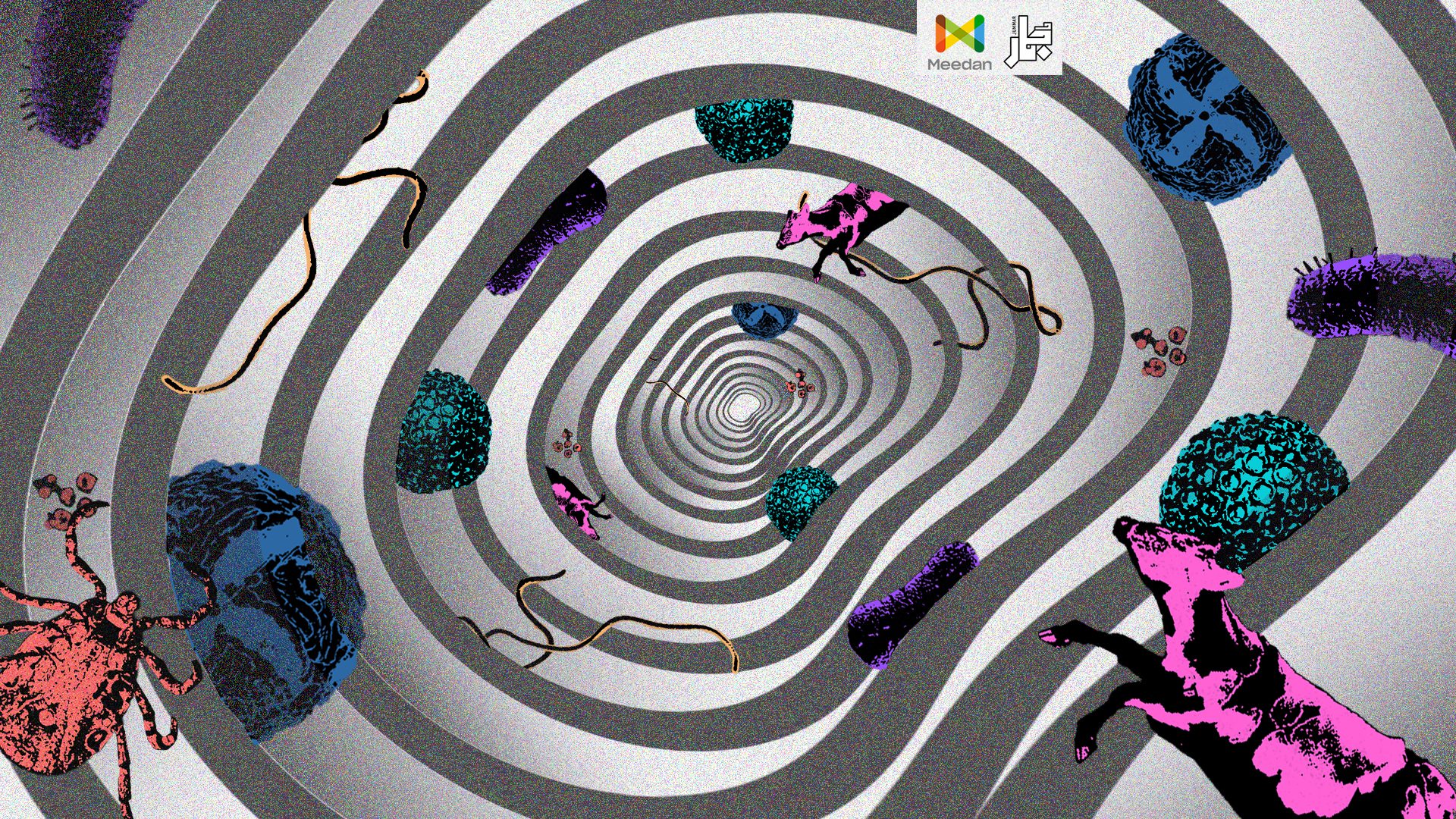“Officials Mediate Livestock Slaughtering”: Hemorrhagic Fever, A Clan of Viruses Threatening Animals and Humans
30 Jul 2023
Dhi Qar is facing a vicious insect that transmits the hemorrhagic fever virus, but it has only a few doctors and veterinary teams to combat it. Thus, a deadly disease is spreading among sheep breeders, butchers, cooks, and consumers of meat, threatening the governorate with a lockdown. The story of how officials are mediating in relation to suspected infected animals and what the disease does to animals and humans.
Every morning, Muhammad Sayyah Al-Badry runs his fingers through his buffaloes’ hair, one after the other, trying to catch ticks to protect his animals from catching the virus that causes them to contract bleeding disorders and fevers that can become severe or even deadly in many cases.
Al-Badry, his buffaloes, and everyone in his governorate are in danger.
He lives near Al-Subul area in Dhi Qar Governorate, where the hemorrhagic fever virus is spreading, infecting people and animals and leaving many sick or dead.
A clan of viruses
Viral hemorrhagic fever (VHF) is caused by several distinct families of viruses, which form a dangerous clan that threaten the lives of humans and animals.

“The insect may be anywhere. The tick may have hidden behind the buffalo’s ear or on its back”. Muhammad trades livestock, and the back-and-forth movement of buffaloes in his barn increases the risk of “hemorrhagic fever” spreading among the animals. The fifty-two-year-old man does not care about the virus’s danger to him, although he may be at a higher risk of dying from it.
Hemorrhagic fever can be transmitted between animals, from animals to humans, and between humans. Some ferrets can also get the virus and transmit it to humans. The virus is transmitted through direct contact with infected people, through the body fluids of an infected person, contact with infected corpses, slaughtering infected animals, and consuming raw meat of infected animals or unpasteurized milk. It is also transmitted through direct contact with ferrets, inhaling or contact with materials contaminated with rodent droppings or mosquitos and tick bites.
The virus threatens mainly livestock owners who breed cows, sheep, and goats, as well as butchers, veterinary, agricultural, and local workers as well as housewives or whoever cooks food.

Hemorrhagic fever can become an epidemic with a high mortality rate, if it is not controlled with proactive medical countermeasures such as vaccines and antivirals. The virus is at a critical outbreak level in Dhi Qar.
History of the virus in Iraq
For four decades, hemorrhagic fever did not become as fierce as it is today in Iraq. Dr Antoine Sabr Al-Banna, a professor at the Faculty of Veterinary Medicine at the University of Baghdad, was the first to diagnose a case of VHF in 1979. However, the virus was under control, as hemorrhagic fever infections did not exceed a dozen cases between 1979 and 2000, and no data on the virus appeared until 2009.
After that, an increasing amount of cases began to appear yearly, but they did not become serious until 2019 when the virus infected 111 people and is estimated to have caused nineteen deaths. The number of cases has been escalating ever since. Between the first of January and May of 2022, Iraq recorded at least 212 cases and twenty-seven deaths from hemorrhagic fever. Dhi Qar alone recorded forty deaths.
Dhi Qar is the most affected governorate by hemorrhagic fever, sustaining about fifty per cent of the total number of cases in Iraq. “If the infected cases remain like this, we are heading towards an outbreak”, says Dr Haidar Ali Hantoush, Head of the Communicable Diseases Division in Dhi Qar.
Hanoush and Dr Muhammad Aziz, Director of the veterinary hospital, point out in their conversation that the virus arrived early in Dhi Qar. Aziz told Jummar that “Dhi Qar is one of the most drought-affected governorates, which enhances the life cycle of ticks”, one of the disease’s most prominent vectors.
Ticks adapt to the harshest environmental conditions, and to complete their three-year life cycle successfully, they must feed on blood. The drought-stricken countryside in Dhi Qar is considered a paradise for this vicious insect. The infected tick transmits any virus it carries into its eggs, including hemorrhagic fever, to reproduce a new generation carrying families of viruses that infect any blood-carrying body.
“Ticks can burrow thirty centimetres underground to avoid all types of pesticides”, Aziz points out. He discusses the insect’s ability to hide and transmit diseases between humans, animals, and from animals to humans and vice versa. “Also, the number of ticks forces medical teams to return to the same place three or four times to disinfect animals, and the required effort needs more cadres to face the crisis”.

Ticks are not the only problem
However, ticks are not the only carrier of the virus, as Dhi Qar has a record rife with environmental violations, one of which is unregulated and unmonitored butchery that spreads hemorrhagic fever, as it creates ideal conditions for transmitting viruses.
“The main cause of hemorrhagic fever is the lack of supervision in the slaughter of livestock”, says the Ministry of Health, while the Ministry of Agriculture declares its inability to control irregular slaughter in the entire country. Still, it has ordered all governorates, security agencies, and municipal administrations to prevent unregulated slaughter and prohibit red meat in the epicentres.
Twelve kilograms of red meat are consumed annually per person in Iraq, according to statistics from the Ministry of Agriculture in 2020, and this meat mostly comes from animals slaughtered in unregulated slaughterhouses. “There are no regular slaughterhouses in Dhi Qar, except for a small one located in Suq Al-Shuyoukh district” in the southeast of the governorate. “As for Al-Nasiriyah slaughterhouse affiliated with the municipality department, it has been closed by a judicial order due to the lack of required environmental determinants”, said Kareem Hani, Director of Dhi Qar Environmental Divison.
Al-Nasiriyah slaughterhouse
Al-Nasiriyah slaughterhouse is in Al-Nahr Street leads to the Uor district, which is full of residential communities and orchards. The slaughterhouse is suspected of polluting the water. The building designated for slaughter is no longer usable, as the area of the building and the slaughtering hall are not fit for purpose, and there is no suitable place for veterinarian supervision of the slaughtering process.

It continues to operate despite orders to close it. The slaughterhouse starts working at three in the morning and closes at seven in the morning every day of the year. “The lack of an alternative is what makes the slaughterhouse continue to operate”, said Ali Abdul-Sattar, Director of Al-Nasiriyah Municipality, which is responsible for managing and monitoring slaughterhouses and ensuring their perpetuation.
“The investment plan for 2023 did not include building a new slaughterhouse”. Therefore, the municipality is waiting for an investor to manage the slaughterhouse. The municipality of Al-Nasiriyah admits its inability to implement measures to reduce contamination that results from livestock slaughtering, as it can neither provide a modern slaughterhouse that monopolises the livestock slaughtering processes nor is it able to reduce unsupervised slaughtering in the city’s districts and squares.
According to international standards, every 350,000 individuals must have a slaughterhouse that provides them with meat. However, Iraq has only a few slaughterhouses, with most violating environmental standards, and the population of Dhi Qar is over two million.



Mediations for livestock slaughtering
Butchers enter their shops at dawn and close the doors to slaughter livestock, as it has become socially reprehensible for the slaughtering process to take place in front of the shops, as in past years.
We spoke to a few butchers, and they all said that they follow the instructions of the Ministries of Agriculture and Health during the slaughtering process, such as wearing masks, medical gloves, and using hot water. They also emphasised that they wash the livestock continuously and under the supervision of a veterinarian. However, the slaughtering process of these livestock is illegal, and the municipality has taken measures against them.



“The official procedure from our side is to seize the livestock that would have been slaughtered illegally” to reduce unsupervised slaughtering, said Ali Abdul-Sattar, Director of Al-Nasiriyah Municipality. After confiscation, the municipality becomes responsible for the livestock until it is sold in a public auction.
However, some livestock are returned to their owners who have connections with the deputies or who seek help. “When we have seized livestock that was being slaughtered irregularly and wanted to refer them to auction, some deputies and government officials contacted us and demanded that the process stops with repeated excuses, such as the livestock belongs to poor people, asking us to sympathise with them”.
The municipality cannot afford the costs of confiscation. “Livestock need fodder, care, and attention. Fodder may cost a million dinars, so who bears the costs?” Abdul-Sattar added.



Shortage of qualified staff
While hemorrhagic fever is escalating, there are not enough qualified staff to control the virus, and thus, teams of volunteers and the Red Crescent are called upon to help. Still, this year has fewer volunteers.
“To limit the spread of ticks, it is necessary to start spraying livestock barns with chemical control materials, which requires great effort and extensive work”, said Muhammad Aziz, Director of the veterinary hospital. “Last year, the Red Cross contributed additional volunteer teams with 126 volunteers in forty-two teams, which doubled the work and expanded the tick control area”.
This year, however, there are only twenty-two veterinary teams, each with three doctors and a vehicle, with each allowed to hire a worker. These teams stand almost alone in facing hemorrhagic fever and its causes. “This number is incommensurate with the number of existing livestock”.



Dhi Qar has about twenty-six veterinary centres besides the hospital, which is a small number that is not commensurate with the number of livestock or the crisis. According to Dr Bassem Abdul-Hussein, Dean of the Faculty of Veterinary Medicine at Dhi Qar University, the number of doctors assigned to manage these centres is only nine.
This is a significant shortage that may worsen further in the future.
“The veterinary hospital may be without staff after two years, as those hired between 1963 and 1965 will retire and a recruitment drive occurred only once during the rule of Ibrahim Al-Jaafari’s government in 2005. Currently, the best of our faculty joined the hospital after it turned into an educational institute, but there are only nine of them”.
Aziz states that each veterinary centre should have ten teams from the Ministry of Health and the municipality, besides the vehicles and pesticides.
Solutions or closure
“To prevent further infections, two main elements must be worked on: the spraying of livestock and health education. If we can educate livestock owners, butchers and housewives, we can prevent many infections,” says Dr Muhammad Aziz.
On the other hand, Bassem Abdul-Hussein, Dean of the Faculty of Veterinary Medicine at Dhi Qar University, suggests conducting a random “polling test” as it is impossible to examine all animals with PCR. “Samples are taken and collected in one test, then we can determine where the infections have appeared, and then focus on the location of the infections. Then, we can start individual examinations in the specified place”.
According to Abdul-Hussein, this process reduces costs and divides the governorate into thirty or forty zones, and then the “focus” is determined according to the examination results.
“There is definitely an epicentre in the governorate (for the spread of the hemorrhagic fever virus), and it must be identified and treated”, said the Faculty of Veterinary Medicine dean in Dhi Qar. However, viruses may still survive under these measures, as “they have a strategy for transmission. Sometimes, they reproduce inside the human body, even with a strong immunity, but only appear when the body develops another disease”.
According to Aziz, the emergence of more cases may force the local government to start a lockdown in the entire governorate. In this case, “we would deal with all animals as being infected because we cannot distinguish an infected animal from the healthy one, and thus, they all are treated as infected in our view to protect the people and the workers”.
*This article is supported by the Check Global Program – Meedan Foundation.
Read More


“His gaze was intrusive; it pierced my soul”: On the Struggles of Divorced Women in Navigating Courts and Governmental Institutions


“She Brought a Fatwa from Khamenei and Al-Azhar, But It Went Nowhere”: The Struggles of Trans People in the Iraqi Health Sector


“Everyone has a Right to the Kids Except their Mother”: On Women Fighting for the Custody of Their Children


Iraqi Prisoners Blackmailed to Pay To Obtain Release Papers After Completing Their Sentence
Every morning, Muhammad Sayyah Al-Badry runs his fingers through his buffaloes’ hair, one after the other, trying to catch ticks to protect his animals from catching the virus that causes them to contract bleeding disorders and fevers that can become severe or even deadly in many cases.
Al-Badry, his buffaloes, and everyone in his governorate are in danger.
He lives near Al-Subul area in Dhi Qar Governorate, where the hemorrhagic fever virus is spreading, infecting people and animals and leaving many sick or dead.
A clan of viruses
Viral hemorrhagic fever (VHF) is caused by several distinct families of viruses, which form a dangerous clan that threaten the lives of humans and animals.

“The insect may be anywhere. The tick may have hidden behind the buffalo’s ear or on its back”. Muhammad trades livestock, and the back-and-forth movement of buffaloes in his barn increases the risk of “hemorrhagic fever” spreading among the animals. The fifty-two-year-old man does not care about the virus’s danger to him, although he may be at a higher risk of dying from it.
Hemorrhagic fever can be transmitted between animals, from animals to humans, and between humans. Some ferrets can also get the virus and transmit it to humans. The virus is transmitted through direct contact with infected people, through the body fluids of an infected person, contact with infected corpses, slaughtering infected animals, and consuming raw meat of infected animals or unpasteurized milk. It is also transmitted through direct contact with ferrets, inhaling or contact with materials contaminated with rodent droppings or mosquitos and tick bites.
The virus threatens mainly livestock owners who breed cows, sheep, and goats, as well as butchers, veterinary, agricultural, and local workers as well as housewives or whoever cooks food.


Hemorrhagic fever can become an epidemic with a high mortality rate, if it is not controlled with proactive medical countermeasures such as vaccines and antivirals. The virus is at a critical outbreak level in Dhi Qar.
History of the virus in Iraq
For four decades, hemorrhagic fever did not become as fierce as it is today in Iraq. Dr Antoine Sabr Al-Banna, a professor at the Faculty of Veterinary Medicine at the University of Baghdad, was the first to diagnose a case of VHF in 1979. However, the virus was under control, as hemorrhagic fever infections did not exceed a dozen cases between 1979 and 2000, and no data on the virus appeared until 2009.
After that, an increasing amount of cases began to appear yearly, but they did not become serious until 2019 when the virus infected 111 people and is estimated to have caused nineteen deaths. The number of cases has been escalating ever since. Between the first of January and May of 2022, Iraq recorded at least 212 cases and twenty-seven deaths from hemorrhagic fever. Dhi Qar alone recorded forty deaths.
Dhi Qar is the most affected governorate by hemorrhagic fever, sustaining about fifty per cent of the total number of cases in Iraq. “If the infected cases remain like this, we are heading towards an outbreak”, says Dr Haidar Ali Hantoush, Head of the Communicable Diseases Division in Dhi Qar.
Hanoush and Dr Muhammad Aziz, Director of the veterinary hospital, point out in their conversation that the virus arrived early in Dhi Qar. Aziz told Jummar that “Dhi Qar is one of the most drought-affected governorates, which enhances the life cycle of ticks”, one of the disease’s most prominent vectors.
Ticks adapt to the harshest environmental conditions, and to complete their three-year life cycle successfully, they must feed on blood. The drought-stricken countryside in Dhi Qar is considered a paradise for this vicious insect. The infected tick transmits any virus it carries into its eggs, including hemorrhagic fever, to reproduce a new generation carrying families of viruses that infect any blood-carrying body.
“Ticks can burrow thirty centimetres underground to avoid all types of pesticides”, Aziz points out. He discusses the insect’s ability to hide and transmit diseases between humans, animals, and from animals to humans and vice versa. “Also, the number of ticks forces medical teams to return to the same place three or four times to disinfect animals, and the required effort needs more cadres to face the crisis”.


Ticks are not the only problem
However, ticks are not the only carrier of the virus, as Dhi Qar has a record rife with environmental violations, one of which is unregulated and unmonitored butchery that spreads hemorrhagic fever, as it creates ideal conditions for transmitting viruses.
“The main cause of hemorrhagic fever is the lack of supervision in the slaughter of livestock”, says the Ministry of Health, while the Ministry of Agriculture declares its inability to control irregular slaughter in the entire country. Still, it has ordered all governorates, security agencies, and municipal administrations to prevent unregulated slaughter and prohibit red meat in the epicentres.
Twelve kilograms of red meat are consumed annually per person in Iraq, according to statistics from the Ministry of Agriculture in 2020, and this meat mostly comes from animals slaughtered in unregulated slaughterhouses. “There are no regular slaughterhouses in Dhi Qar, except for a small one located in Suq Al-Shuyoukh district” in the southeast of the governorate. “As for Al-Nasiriyah slaughterhouse affiliated with the municipality department, it has been closed by a judicial order due to the lack of required environmental determinants”, said Kareem Hani, Director of Dhi Qar Environmental Divison.
Al-Nasiriyah slaughterhouse
Al-Nasiriyah slaughterhouse is in Al-Nahr Street leads to the Uor district, which is full of residential communities and orchards. The slaughterhouse is suspected of polluting the water. The building designated for slaughter is no longer usable, as the area of the building and the slaughtering hall are not fit for purpose, and there is no suitable place for veterinarian supervision of the slaughtering process.



It continues to operate despite orders to close it. The slaughterhouse starts working at three in the morning and closes at seven in the morning every day of the year. “The lack of an alternative is what makes the slaughterhouse continue to operate”, said Ali Abdul-Sattar, Director of Al-Nasiriyah Municipality, which is responsible for managing and monitoring slaughterhouses and ensuring their perpetuation.
“The investment plan for 2023 did not include building a new slaughterhouse”. Therefore, the municipality is waiting for an investor to manage the slaughterhouse. The municipality of Al-Nasiriyah admits its inability to implement measures to reduce contamination that results from livestock slaughtering, as it can neither provide a modern slaughterhouse that monopolises the livestock slaughtering processes nor is it able to reduce unsupervised slaughtering in the city’s districts and squares.
According to international standards, every 350,000 individuals must have a slaughterhouse that provides them with meat. However, Iraq has only a few slaughterhouses, with most violating environmental standards, and the population of Dhi Qar is over two million.



Mediations for livestock slaughtering
Butchers enter their shops at dawn and close the doors to slaughter livestock, as it has become socially reprehensible for the slaughtering process to take place in front of the shops, as in past years.
We spoke to a few butchers, and they all said that they follow the instructions of the Ministries of Agriculture and Health during the slaughtering process, such as wearing masks, medical gloves, and using hot water. They also emphasised that they wash the livestock continuously and under the supervision of a veterinarian. However, the slaughtering process of these livestock is illegal, and the municipality has taken measures against them.



“The official procedure from our side is to seize the livestock that would have been slaughtered illegally” to reduce unsupervised slaughtering, said Ali Abdul-Sattar, Director of Al-Nasiriyah Municipality. After confiscation, the municipality becomes responsible for the livestock until it is sold in a public auction.
However, some livestock are returned to their owners who have connections with the deputies or who seek help. “When we have seized livestock that was being slaughtered irregularly and wanted to refer them to auction, some deputies and government officials contacted us and demanded that the process stops with repeated excuses, such as the livestock belongs to poor people, asking us to sympathise with them”.
The municipality cannot afford the costs of confiscation. “Livestock need fodder, care, and attention. Fodder may cost a million dinars, so who bears the costs?” Abdul-Sattar added.



Shortage of qualified staff
While hemorrhagic fever is escalating, there are not enough qualified staff to control the virus, and thus, teams of volunteers and the Red Crescent are called upon to help. Still, this year has fewer volunteers.
“To limit the spread of ticks, it is necessary to start spraying livestock barns with chemical control materials, which requires great effort and extensive work”, said Muhammad Aziz, Director of the veterinary hospital. “Last year, the Red Cross contributed additional volunteer teams with 126 volunteers in forty-two teams, which doubled the work and expanded the tick control area”.
This year, however, there are only twenty-two veterinary teams, each with three doctors and a vehicle, with each allowed to hire a worker. These teams stand almost alone in facing hemorrhagic fever and its causes. “This number is incommensurate with the number of existing livestock”.



Dhi Qar has about twenty-six veterinary centres besides the hospital, which is a small number that is not commensurate with the number of livestock or the crisis. According to Dr Bassem Abdul-Hussein, Dean of the Faculty of Veterinary Medicine at Dhi Qar University, the number of doctors assigned to manage these centres is only nine.
This is a significant shortage that may worsen further in the future.
“The veterinary hospital may be without staff after two years, as those hired between 1963 and 1965 will retire and a recruitment drive occurred only once during the rule of Ibrahim Al-Jaafari’s government in 2005. Currently, the best of our faculty joined the hospital after it turned into an educational institute, but there are only nine of them”.
Aziz states that each veterinary centre should have ten teams from the Ministry of Health and the municipality, besides the vehicles and pesticides.
Solutions or closure
“To prevent further infections, two main elements must be worked on: the spraying of livestock and health education. If we can educate livestock owners, butchers and housewives, we can prevent many infections,” says Dr Muhammad Aziz.
On the other hand, Bassem Abdul-Hussein, Dean of the Faculty of Veterinary Medicine at Dhi Qar University, suggests conducting a random “polling test” as it is impossible to examine all animals with PCR. “Samples are taken and collected in one test, then we can determine where the infections have appeared, and then focus on the location of the infections. Then, we can start individual examinations in the specified place”.
According to Abdul-Hussein, this process reduces costs and divides the governorate into thirty or forty zones, and then the “focus” is determined according to the examination results.
“There is definitely an epicentre in the governorate (for the spread of the hemorrhagic fever virus), and it must be identified and treated”, said the Faculty of Veterinary Medicine dean in Dhi Qar. However, viruses may still survive under these measures, as “they have a strategy for transmission. Sometimes, they reproduce inside the human body, even with a strong immunity, but only appear when the body develops another disease”.
According to Aziz, the emergence of more cases may force the local government to start a lockdown in the entire governorate. In this case, “we would deal with all animals as being infected because we cannot distinguish an infected animal from the healthy one, and thus, they all are treated as infected in our view to protect the people and the workers”.
*This article is supported by the Check Global Program – Meedan Foundation.





